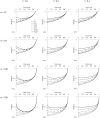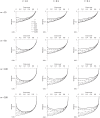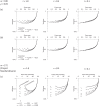Optimal design of cluster randomised trials with continuous recruitment and prospective baseline period
- PMID: 33685241
- PMCID: PMC8010895
- DOI: 10.1177/1740774520976564
Optimal design of cluster randomised trials with continuous recruitment and prospective baseline period
Abstract
Background: Cluster randomised trials, like individually randomised trials, may benefit from a baseline period of data collection. We consider trials in which clusters prospectively recruit or identify participants as a continuous process over a given calendar period, and ask whether and for how long investigators should collect baseline data as part of the trial, in order to maximise precision.
Methods: We show how to calculate and plot the variance of the treatment effect estimator for different lengths of baseline period in a range of scenarios, and offer general advice.
Results: In some circumstances it is optimal not to include a baseline, while in others there is an optimal duration for the baseline. All other things being equal, the circumstances where it is preferable not to include a baseline period are those with a smaller recruitment rate, smaller intracluster correlation, greater decay in the intracluster correlation over time, or wider transition period between recruitment under control and intervention conditions.
Conclusion: The variance of the treatment effect estimator can be calculated numerically, and plotted against the duration of baseline to inform design. It would be of interest to extend these investigations to cluster randomised trial designs with more than two randomised sequences of control and intervention condition, including stepped wedge designs.
Keywords: Efficient design; group randomised trials; power; sample size.
Conflict of interest statement
Figures






Similar articles
-
Efficient designs for three-sequence stepped wedge trials with continuous recruitment.Clin Trials. 2024 Dec;21(6):723-733. doi: 10.1177/17407745241251780. Epub 2024 May 21. Clin Trials. 2024. PMID: 38773924 Free PMC article.
-
The optimal design of stepped wedge trials with equal allocation to sequences and a comparison to other trial designs.Clin Trials. 2017 Dec;14(6):639-647. doi: 10.1177/1740774517723921. Epub 2017 Aug 10. Clin Trials. 2017. PMID: 28797179 Free PMC article.
-
Folic acid supplementation and malaria susceptibility and severity among people taking antifolate antimalarial drugs in endemic areas.Cochrane Database Syst Rev. 2022 Feb 1;2(2022):CD014217. doi: 10.1002/14651858.CD014217. Cochrane Database Syst Rev. 2022. PMID: 36321557 Free PMC article.
-
The impact of varying cluster size in cross-sectional stepped-wedge cluster randomised trials.BMC Med Res Methodol. 2019 Jun 14;19(1):123. doi: 10.1186/s12874-019-0760-6. BMC Med Res Methodol. 2019. PMID: 31200640 Free PMC article.
-
Developing Statistical Methods to Improve Stepped-Wedge Cluster Randomized Trials [Internet].Washington (DC): Patient-Centered Outcomes Research Institute (PCORI); 2021 Aug. Washington (DC): Patient-Centered Outcomes Research Institute (PCORI); 2021 Aug. PMID: 38913814 Free Books & Documents. Review.
Cited by
-
Key considerations for designing, conducting and analysing a cluster randomized trial.Int J Epidemiol. 2023 Oct 5;52(5):1648-1658. doi: 10.1093/ije/dyad064. Int J Epidemiol. 2023. PMID: 37203433 Free PMC article.
-
Efficient designs for three-sequence stepped wedge trials with continuous recruitment.Clin Trials. 2024 Dec;21(6):723-733. doi: 10.1177/17407745241251780. Epub 2024 May 21. Clin Trials. 2024. PMID: 38773924 Free PMC article.
-
Optimal study designs for cluster randomised trials: An overview of methods and results.Stat Methods Med Res. 2023 Nov;32(11):2135-2157. doi: 10.1177/09622802231202379. Epub 2023 Oct 6. Stat Methods Med Res. 2023. PMID: 37802096 Free PMC article. Review.
-
How Should Parallel Cluster Randomized Trials With a Baseline Period be Analyzed?-A Survey of Estimands and Common Estimators.Biom J. 2025 Jun;67(3):e70052. doi: 10.1002/bimj.70052. Biom J. 2025. PMID: 40302411 Free PMC article.
References
-
- Donner A, Klar N. Design and analysis of cluster randomization trials in health research. London: Arnold Publishing, 2000.
-
- Hooper R, Forbes A, Hemming K, et al.. Analysis of cluster randomised trials with an assessment of outcome at baseline. BMJ 2018; 360: k1121. - PubMed
Publication types
MeSH terms
Grants and funding
LinkOut - more resources
Full Text Sources
Other Literature Sources

